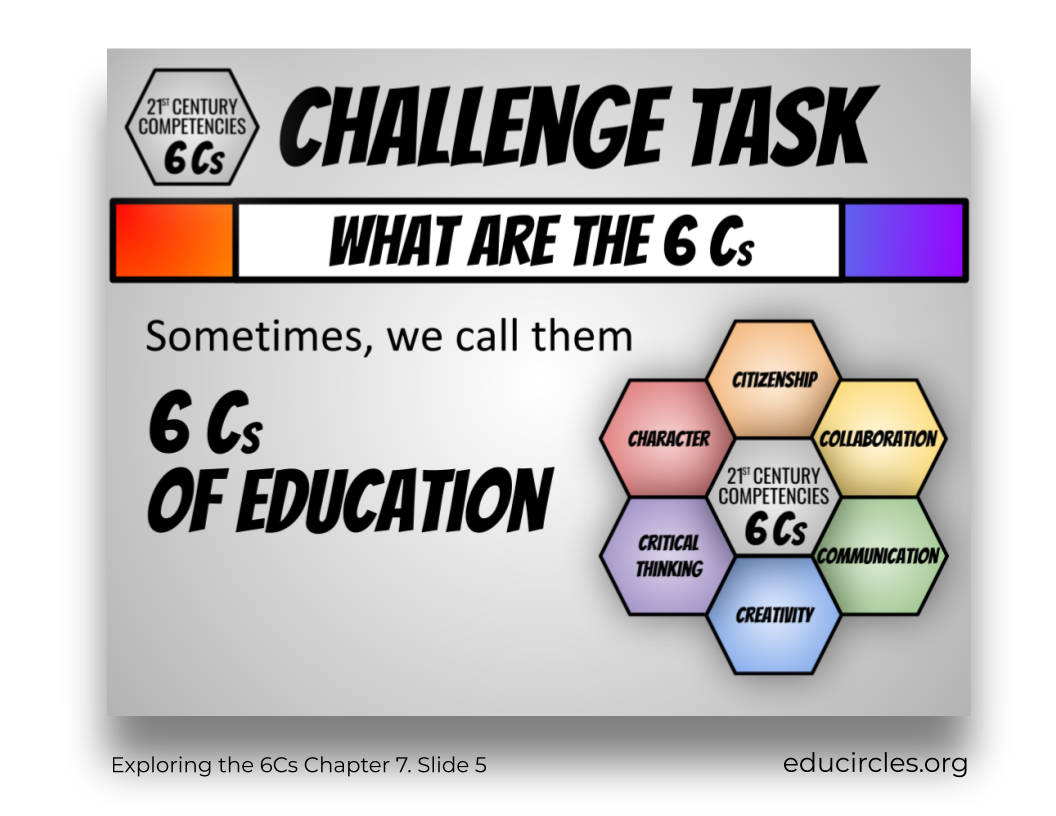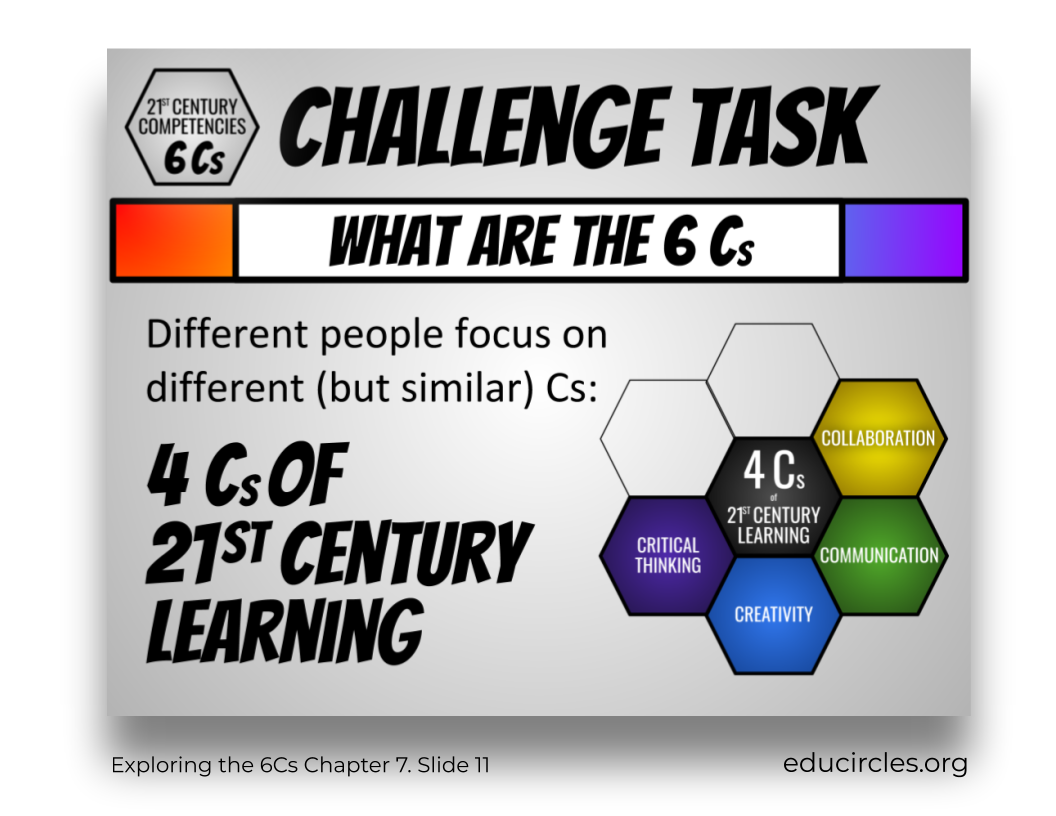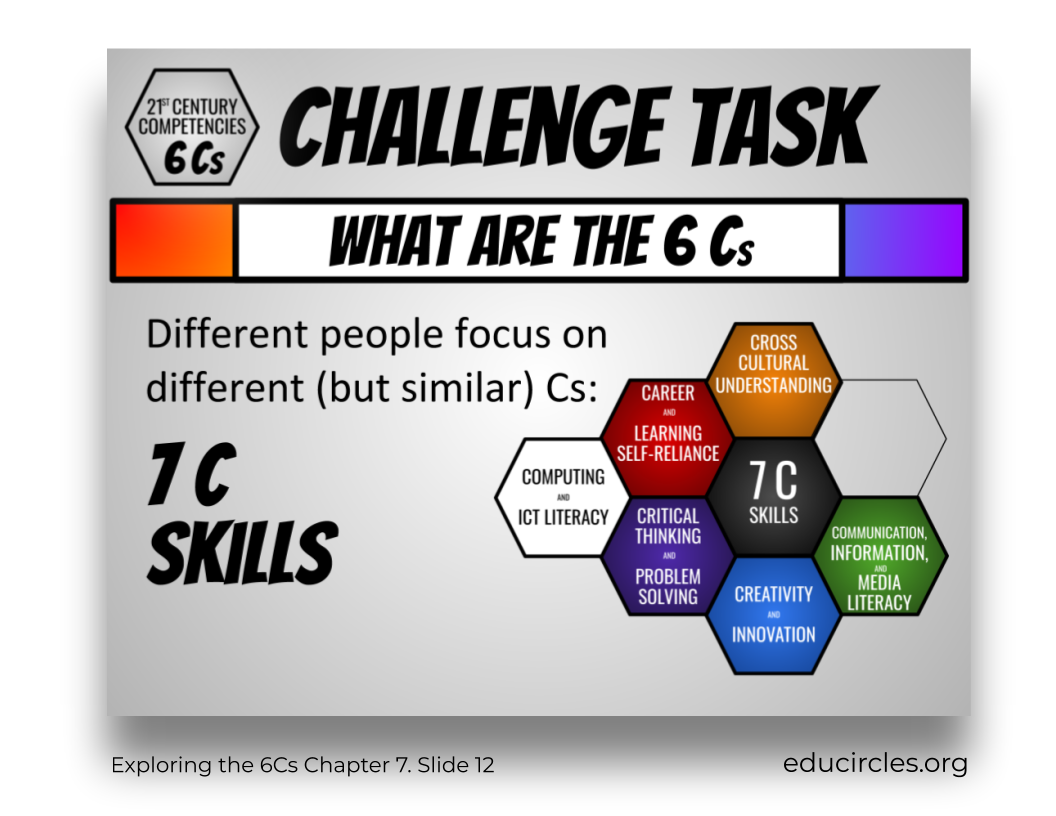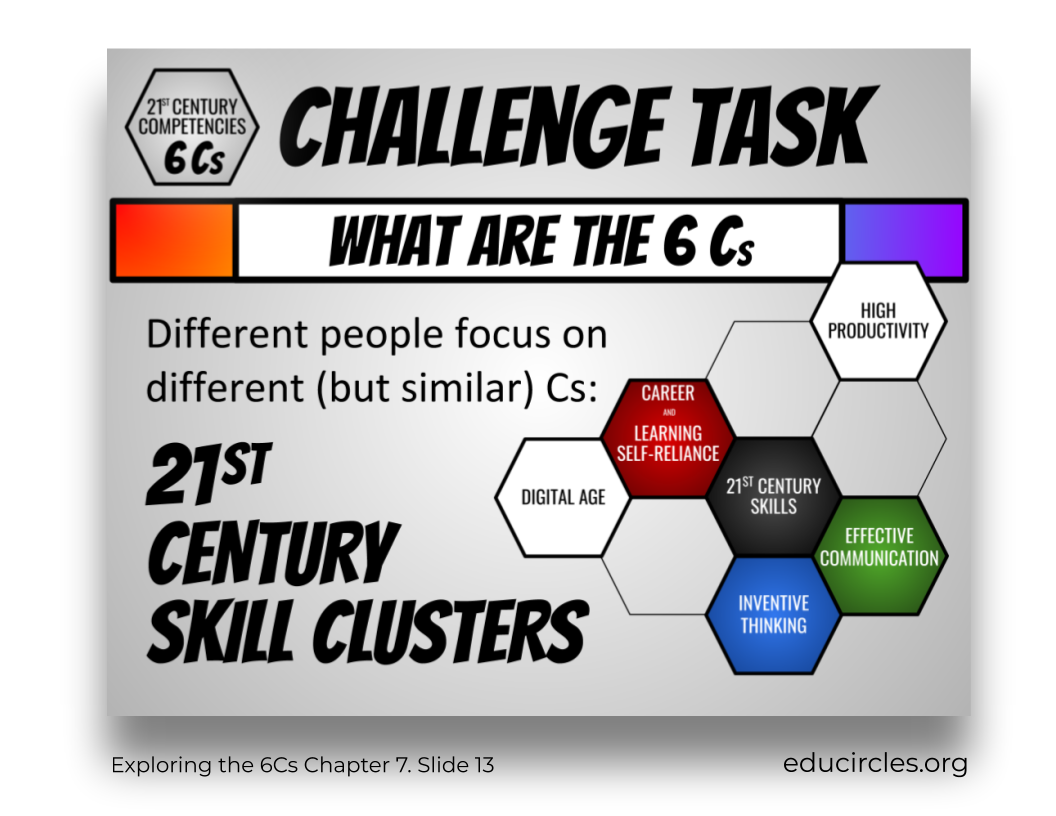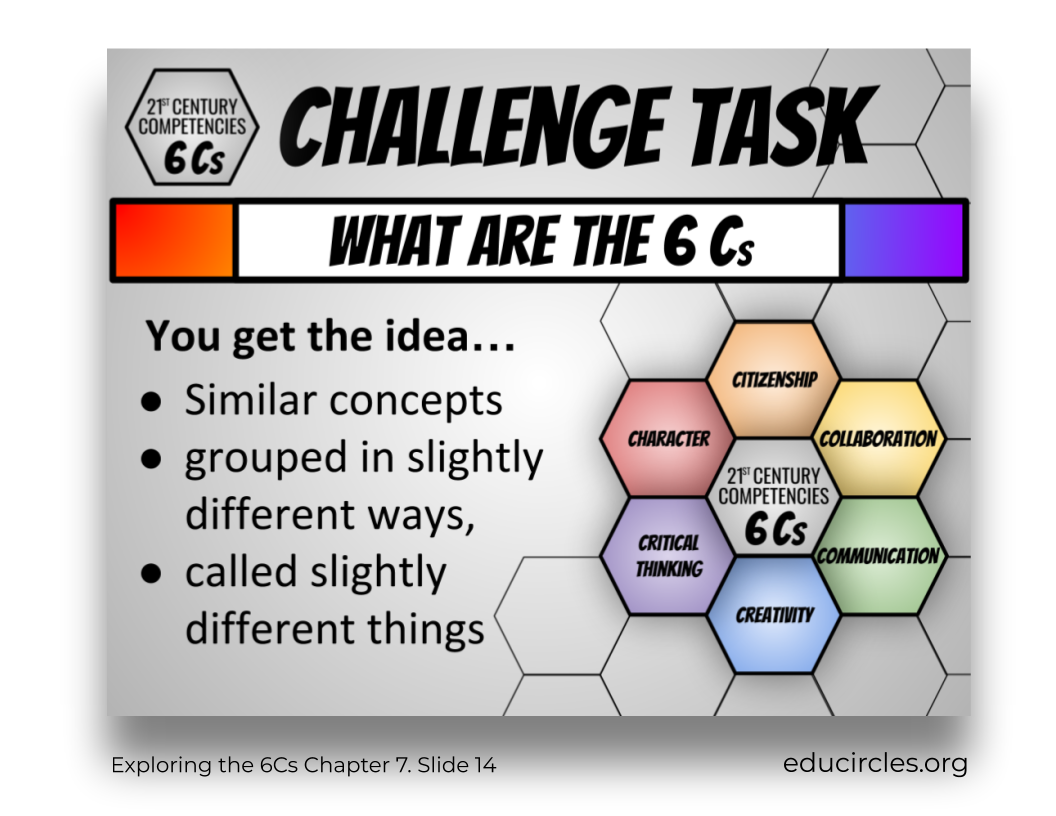Social Emotional Learning Skills Classroom Challenge: The ultimate growth mindset class challenge!
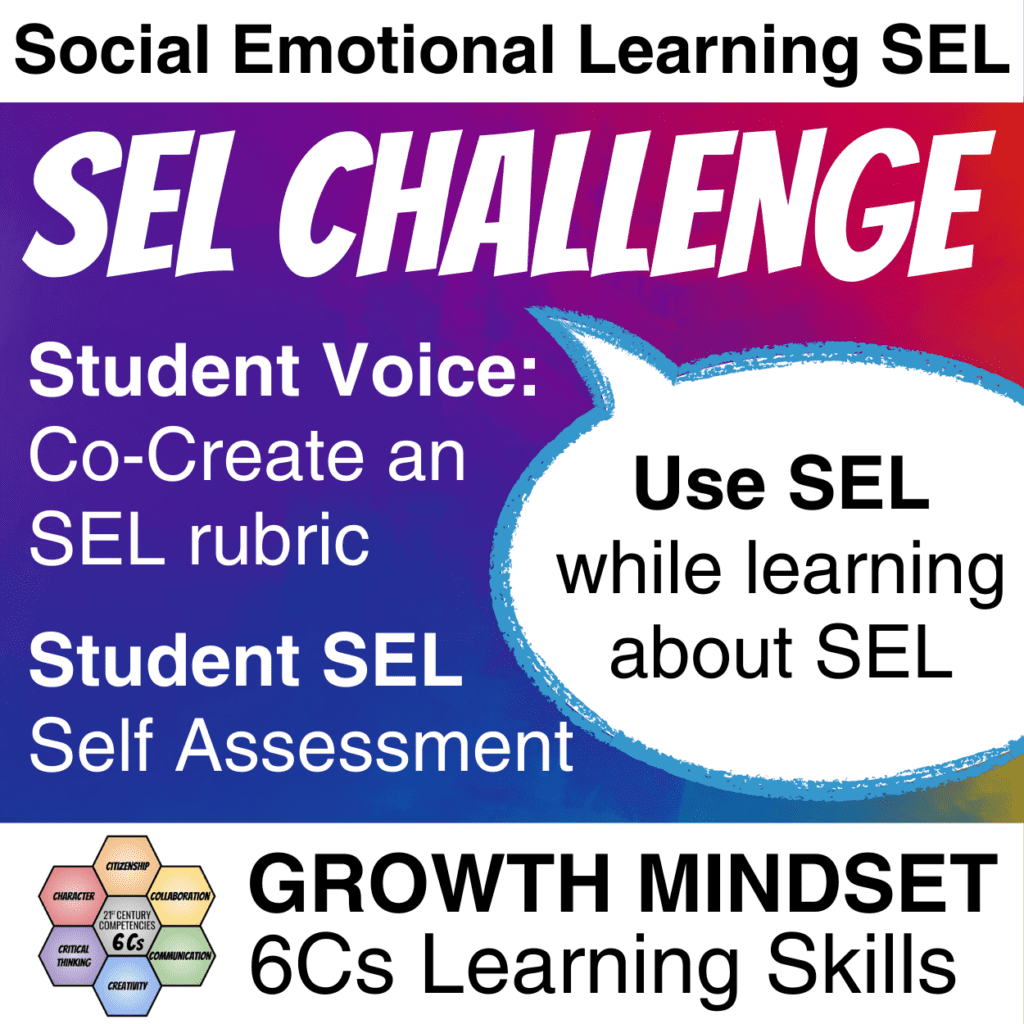
Social Emotional Learning 6Cs Class Challenge – Mar 1, 2024 update: Challenge your class with these thirteen (13) activities and 21st-Century Learning skills lessons.
- Kickstart your class in March by helping students to learn how to learn.
- Empower a growth mindset to deal with a changing world by exploring the 6 Cs of Education.
Do we really need to teach students Social Emotional Learning Skills?
You know that saying, there’s nothing common about common sense?
It’s kind of like that.
Social Emotional Learning SEL activities to develop 21st-century skills are different from the lessons we did when we were students:
- read that,
- memorize this, and
- answer questions with one correct solution.
Learning HOW to learn is an essential 21st-century skill
Do you have kids? I do.
My daughter is in Grade 7. In five years, she will be graduating high school. She’ll probably go to university for another four years. That’s because her parents and her teachers have told her that’s what she should do to be successful.
Go to school, go to university, and get a good job.
So, in five to ten years, she’ll be on her own.
And I wonder if she will have learned how to adapt and take care of herself.
What is your kid (really) learning at school?
I know my daughter will be great at following instructions.
She’s a great kid. She’ll sit in class as she’s told to do. She’ll raise her hand. She will memorize vocabulary and study for tests. She’ll learn how to play the game of school. She wants great marks because she thinks marks are important.
But, after five to ten years of education, will she know how to learn something independently?
Sure, she’ll be able to memorize facts because she’s told to read this handout, answer the questions, go to that website, and think about this issue.
But, are your kid’s teachers doing Social Emotional Learning activities to develop 21st-century skills?
GROWTH MINDSET: Will my kid learn that “learning” is an ongoing process?
- That she’ll have to learn new things on her own?
- When she doesn’t figure it out right away, she’ll have to be self-motivated to find an answer herself?
- Raising your hand and waiting for someone to give you the answer doesn’t really happen with this whole adulting thing.
CHARACTER: Does my child learn how to pick herself up when the world is unfair and knocks her down?
- Does she develop strategies to keep going?
- Will she get opportunities to struggle, fail, and figure out what went wrong?
- Does the teacher incorporate 21st century skills learning activities within the “regular” curriculum (i.e. English, Math, Science, Art, Phys-ed) so that it’s seen as part of everyday learning (and not some add-on like advisory or homeroom class?)
CITIZENSHIP:
- Will my child be able to learn how to stand up for herself and her friends?
- When she sees something that is not right, will she have the skills to be an active bystander who takes action?
COLLABORATION: Can she learn how to work with other people in a group
- Will my daughter be able to recognize sometimes things are faster if we divide and conquer tasks based on what we’re good at?
- Does my child understand that collaboration is not the same as teamwork?
- Are there opportunities to practice true collaboration where the group creates new understanding or new ideas that aren’t known beforehand?
COMMUNICATION: Does my daughter learn how to advocate for herself and be assertive?
- Will she learn that sometimes, being assertive as a communication strategy works, but not all the time?
- Can she adapt and learn how to get her point across with different people?
- Is there a time when it’s okay to be aggressive? Or passive? Or passive-aggressive?
- Do we have to be assertive about everything?
CREATIVITY: Should my child learn how to make her own luck and connect the dots in new ways?
- The answers aren’t always obvious in life. In school, there
- Can she create new learning lessons for herself, or does she need someone to tell her what to do?
CRITICAL THINKING: Will my kid learn different ways to come up with her own informed opinion?
- Will she learn how to make a logical decision?
- Can she apply criteria in new situations of her own choosing to decide for herself?
- Does she get opportunities to challenge ideas that people tell her – even if it comes from the teacher?
- Can we trust the information we get from traditional news media (i.e. mainstream news outlets like TV news channels, large newspapers?)
- Can we trust when people say traditional news media are fake news?
Does my kid learn that the world isn’t always black and white?
Will school teach my child that the only constant is change. In fact, the world we know today isn’t necessarily the rules we play by tomorrow?
Or, will my child’s teacher do the same thing our teachers did: read this, memorize that, follow these steps quickly to get the “right” answer! I need to cover the curriculum!
What are we teaching our students?
Okay. I know we have to teach the curriculum. There’s too much in there and not enough time.
And, don’t get me started on standardized tests.
Plus, all of the other things teachers have to do.
Then, throw in a pandemic. This isn’t the job we started with. Remember group work without masks and physical distancing?
Sometimes life seems too overwhelming. When that happens for me, I have to simplify things. Big goals can be crushing.
If you want to teach your students 21st-century learning skills (i.e. how to learn to survive and thrive,) then use this lesson plan.
Each handout goes over a specific learning skill: character, citizenship, collaboration, communication, creativity, critical thinking.
So, let’s just take it one handout at a time. Go slow.
- Use the slideshow and the handout to explore that 6C global competency.
- Then have students co-create criteria for that “C” learning skill.
I bet as you teach your regular classroom program, there will be opportunities for students to use their co-created learning skills rubric.
- Students having a tough time working in groups during your classwork?
- Okay, let’s look back at the handout on collaboration.
- Let’s use the co-created student rubric for collaboration and self-evaluate.
- What are we doing well?
- How could we improve? (Psst, look at the rubric.)
As different problems pop up over the year, use the handout for this learning skill to remind students how to learn, struggle and thrive.
If you have questions, please email me at [email protected].
Why are 21st Century Skills and Competencies so important?
- Life can be unpredictable and ever changing. (Hello, Covid-19)
- Life can be unfair. (Hello, systemic racism)
- Life can throw you a curve ball. (Hello, unexpected challenge)
WHAT WE TEACH… is mandated by the government.
In Canada, we call this the curriculum. In the US, we call these standards.
Every government and jurisdiction has standards and expectations.
For example, If you’re in the US, you probably recognize the Common Core State Standards for English Language Arts & Literacy.
But, it’s really not that different from the Ontario Language Arts curriculum in Canada.
What we teach is set for us…
But, HOW WE TEACH is up to us…
That’s where teachers do so much.
We shape the future not only in what we say but how we say it.
And 21st Century Social-Emotional learning skills provide a framework to think our students need to be successful in a changing world.
- The easy part is using this lesson plan package as a starting point to explicitly teach 21st Century Skills to students.
- The harder part is shifting our classroom programs to focus on getting students to develop these transferrable social-emotional learning skills as they explore the curriculum…
Quick Overview of Learning Activities to Develop 21st Century Skills
This page is about using classroom activities to explore 21st Century Competencies (social-emotional learning skills)
- Introduce 21st Century Competencies / 6 Cs
- Give students an opportunity to use 21st Century Competencies.
- Students work in groups to co-create a rubric to assess 21st Century Social-Emotional Learning skills (classroom activity)
If you’re looking for other 21st Century Social Emotional Learning Lesson Plans that focus on a specific competency…
The 21st-century competencies / 6 Cs have a lot of meat to them.
Here are some other 21st-century lesson plans.
Each includes activities, videos, and strategies to help students explore each of the 6 Cs separately:
- Character unit
- Citizenship unit
- Collaboration unit
- Communication unit
- Creativity and Innovation unit
- Critical Thinking unit
In this SEL classroom group challenge unit…
Students work in groups:
- learn about each of the 6 Cs of Education
- create a rubric together for each of the 21st Century Skills
- find similarities and differences between these soft skills / 21st Century competencies.
Students develop a deeper understanding of the 6 Cs of Education by comparing and contrasting the 21st-century skills.
But, they’re also getting an opportunity to use the 21st-century competencies themselves. These are important soft skills that are transferrable between, school, life, and work.
- So, students work in groups to compare the 6 Cs,
- while using the 6 Cs.
- Then, they get a chance to self-assess their ability to demonstrate 21st Century Competencies (using a rubric they helped to co-create)…
- while the teacher gets a chance to observe and assess their learning skills for report card magic.
It’s like looking at a mirror’s reflection in a mirror… It’s very meta.
Mind blown.
Different ways to use these 21st Century skills lesson plans
Originally this lesson package was created as a culminating task for our unit on Exploring the 6 Cs.
But, this lesson plan works equally well as an introduction to the 6 Cs during New Year activities.
Sure, it’ll take a little longer to go through the slideshow with students if you’re introducing material for the first time, but this package works well as a stand-alone exploration of 21st Century Skills.
- You get handouts so students learn each of the 6 Cs, one by one
- You also get some of the key slides from each of our lesson packages on the 6Cs.
What are 21st Century Skills / 6 Cs of Education?
Well, it all depends on who you ask! ( This wikipedia article shows you some of the different thoughts around these 6Cs.)
Basically 21st Century skills are about preparing students to succeed in a changing global world.
We can teach these 21st Century competencies as we teach the curriculum to students.
7 C Skills
1. Cross Cultural Understanding
2. Career and Learning Self-Reliance
3. Computing and ICT Literacy
4. Critical Thinking and Problem Solving
5. Creativity and Innovation
6. Communication, Information and Media Literacy.
21st Century Skill Clusters
1. Career and Learning Self-Reliance
2. Digital Age
3. Effective Communication
4. Inventive Thinking
5. High Productivity
HOW TO TEACH 21st Century Skills to students: Group Challenge Table of Contents
How do you teach 21st Century Skills / Competencies to your students if you’re not really sure what they are yourself?
No problem.
Download these 21st century skills learning activities as a starting point to explore with your students!
(If you’re not sure what 21st Century Skills / Competencies are or what the 6Cs of Education are, check out this post.)
KEY CONCEPTS:
We provide over 2 weeks of 21st century skills lesson plans to do with your class:
- Learn (or consolidate knowledge) about the 6Cs,
- Co-create a rubric to assess each of the 6 Cs,
- compare and contrast the 6 Cs… while using the 6 Cs
- assess student ability to demonstrate 21st Century Skills / Competencies.
You get:
- a Microsoft Powerpoint / Google Slideshow explaining all of the 6 Cs and teaching your students strategies and the process to co-create a rubric.
- a one page summary handout explaining each of the 6 Cs (Character, Citizenship, Collaboration, Communication, Creativity, and Critical Thinking)
- handouts to help students brainstorm and identify key aspects for each C.
- a small group / whole class collaboration task to create new knowledge and to evaluate what are the key success criteria for each of the 6 Cs.
- a small group / whole class collaboration task for students to demonstrate their ability to use the 6 Cs while trying to analyze the 6 Cs (compare and contrast)
- an optional summative performance task or written response assessment.
YOU GET 311 SLIDES and PAGES in 13 21st Century Skills Lesson plans
- 147 slides in POWERPOINT and GOOGLE SLIDE format
- 80 page lesson plan PDF with 13 lessons (45-60 min each.)
- 6 page handout – 21st Century Skills – Notes “Show, Don’t Tell”
- 6 page handout – Look Fors / Success Criteria for each of the 21st Century Skills (6 Cs)
- 3 page handout – Compare and Contrast the 21st Century Skills
- Student self assessment handout (3 versions)
- Teacher class tracking sheet (4 versions)’
Optional stuff:
- a 3 page handout to Compare and Contrast (Question #2)
- another 3 page handout – Compare and Contrast (Question #3)
- Chapter Review – Question #3
Why yes, we did just save you an incredible amount of prep work!
And of the slides and handouts look fantastic and you get edit the Powerpoint, Google Slide, and the Microsoft Word files.
NOTE: Answer Key not provided as student answers will vary based on class discussions. The point of the Challenge Task is to have classes collaborate and generate new ideas based on their evolving understanding of 21st Century Skills / Competencies.

21st Century Social-Emotional Learning Skills Classroom Activities unit outline
13 lessons to explore 21st Century Skills (Social Emotional Learning) with your class
This unit is based on a 50 minute period schedule. I try to provide around 45-50 min of content per lesson.
Depending on your teaching style and classroom dynamics, you may find things go longer or shorter than the suggested times.
A detailed 80 page lesson plan is included in PDF format (as well as in the slide notes of the Powerpoint Presentation / Google Slides.)
Use these learning activities to develop 21st century skills rubrics with your class.
- Students can use these co-created rubrics to assess their own ability to use the 6Cs.
- You can also use these student generated 21st century skills rubrics to provide a learning skills mark for report cards!
PART 1. What are the 6 Cs / 21st Century Skills
DAY/LESSON 1 – What are the 6Cs / Notes – Show don’t tell (slides 1-48) – 60 MIN
- Introduction (slides 1-14) – 5 minutes
- Part 1. Notes – Show Don’t Tell
- Introduction Handout 4a Notes (Show dont tell) – 5 minutes
- Character – 25 minutes
- Citizenship – 25 minutes
DAY/LESSON 2 – Notes – Show don’t tell (slides 49-72) – 50 MIN
- Part 1. Notes – Show Don’t Tell (Continued)
- Collaboration – 25 minutes
- Communication – 25 minutes
DAY/LESSON 3 – Notes – Show don’t tell (slides 73-96) – 50 MIN
- Part 1. Notes – Show Don’t Tell (Continued)
- Creativity – 25 minutes
- Critical Thinking – 25 minutes
PART 2. Co-Creating Rubrics / Success Criteria
DAY/LESSON 4 – Look Fors Introduction / Co-Creating criteria – CHARACTER (slides 97-113) – 55 MIN
- Introduction (slides 97-103) – 10 minutes
- Co-creating assessment criteria for Character (slide 104-113) – 45 minutes
NOTE: Lessons 5-9 use the same slides to co-create criteria for the other 6 Cs
- You can either show the overview (slide 114) or go through each step to focus students
DAY/LESSON 5 – Co-Creating criteria – CITIZENSHIP (slides 114-118) – 45 MIN
- Co-creating assessment criteria for Citizenship – 45 minutes
DAY/LESSON 6 – Co-Creating criteria – COLLABORATION (slides 114-118) – 45 MIN
- Co-creating assessment criteria for Collaboration – 45 minutes
DAY/LESSON 7 – Co-Creating criteria – COMMUNICATION (slides 114-118) – 45 MIN
- Co-creating assessment criteria for Communication – 45 minutes
DAY/LESSON 8 – Look Fors/Co-Creating criteria – CREATIVITY (slides 114-118) – 45 MIN
- Co-creating assessment criteria for Creativity – 45 minutes
DAY/LESSON 9 – Look Fors/Co-Creating criteria – CRITICAL THINKING (slides 114-118) – 45 MIN
- Co-creating assessment criteria for Critical Thinking – 45 minutes
PART 3. Compare and Contrast the 6 Cs (21st Century Skills)
DAY/LESSON 10 – Compare and Contrast (slides 119-142) – 50 MIN
- Introduction: Thinking about the 6Cs – 10 minutes
- Heads up – You need to use the 6Cs as well – 10 minutes
- Wait! There’s more: Self Assessment / Teacher Assessment – 15 minutes
- Step 1. Independent Thinking (slide 141-142) – 15 minutes
DAY/LESSON 11 – Compare and Contrast – continued (slides 143-145) – 50 MIN
- Step 2. Small Group Collaboration (slide 143) – 30 minute
- Self Assessment (slide 144-145) – 20 minutes
DAY/LESSON 12 – Compare and Contrast – continued (slides 146; 144-145) – 50 MIN
- Step 3. Whole Class Collaboration (slide 146) – 30 minutes
- Update Self Assessment based on Whole Class Conversation (slide 144-145) – 20 minutes
PART 4. Optional Summative Assessment (performance task or individual written task)
DAY/LESSON 13 – OPTIONAL Assessment / Review – (slides 147) – 50 MIN
- Chapter Review Test (slide 147) – 50 min
Read this post to find out how our 21st Century Competencies MEGA BUNDLE can help save you time and money… Or just go get the bundle right now by clicking here.
